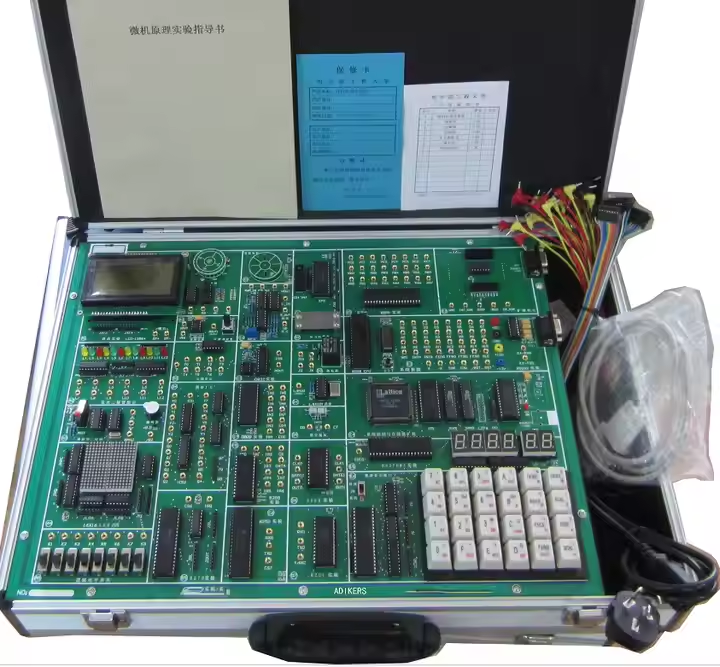Brand: Adikers
Model: AZ239
Product name: Teaching Equipment
Function: Laboratory equipment
Power supply: AC 220V ±10% 50 Hz
Certificate: Design patent certificate
Description: Provide the power and signals required for the experiment
Application: training institute or laboratory
Warranty: 1 year
Product Size: 430*560*150MM
Packaging: Wooden packing
Color: metallic silver
Packaging and delivery
Selling Units: Single item
Single package size: 50X60X20 cm
Single gross weight:10.000 kg
Counytry of Manufacture: Shandong, China
8086 microprocessor trainer kit, Adikers Model: AZ239
Model: AZ239
Product name: Teaching Equipment
Function: Laboratory equipment
Power supply: AC 220V ±10% 50 Hz
Certificate: Design patent certificate
Brand: Adikers
Model: AZ239
1. introduction
This system is the best supporting experimental equipment for teaching courses such as
"Microcomputer Control Technology" and "Sixteen-Bit Microcomputer Principles and
Interfaces". With the design concept of small system, multi-function and easy expansion, the
motherboard is mainly based on the experiments of "8086 Series Microcomputer Experiment
Guide", adding address bus, data bus, control bus lead-out and expansion unit (area), so that
the school can start from the needs , optional expansion modules provide a good experimental
development environment for teaching experiments, curriculum design, and graduation
projects in various colleges and universities.
i) There are two working modes: one is to run with a PC, and realize various debugging and
running operations while being online with the host software; the other is to run offline,
the experimental system comes with its own keyboard, display circuit and monitoring and
management program. In the absence of a PC, the experimental program can also be
debugged through memory reading and writing, single step, breakpoint, full speed and
other methods.
ii) Experimental openness: The experimental circuit unit should be as independent and open
as possible, such as an open keyboard, an open display, an open serial port, etc., to provide
the possibility to adapt to a variety of experiments.
iii)Necessary measuring instruments: Equipped with dual-channel virtual oscilloscope
measurement card.
2. System composition
i) Microcomputer system expansion: CPU (8088), system control chip (1032), 64K monitoring program memory, 64K user program and data memory
(61256x2), 64K experimental program memory, open 4*6 keyboard circuit, open 6-digit dynamic digital tube display circuit, Equipped with serial port or USB communication mode, the factory configuration is serial port.
ii) Input Output: 128*64 LCD graphic circuit (or character 1602 LCD), 8-bit switch logic level input/output circuit, single pulse generator, 8MH clock frequency division, 16*16 LED dot matrix circuit, audio power amplifier, 0~5V Adjustable analog quantity, PWM circuit, emitter follower, printing port, user serial interface.
iii) Commonly used interface chips: 74LS273, 74LS244, 8279, 0832, 0809, 8259, 8250, 8253, 8251, 8255, 8237, RS232, etc.;
iv) control target: Horns, buzzers, small DC motors, stepper motors, pressure sensors, temperature sensors, relays, etc.;
v) Expansion unit interface: Provide bus interface, you can expand the design by yourself or choose our company's expansion module
vi) software: The system is equipped with microcomputer simulation and debugging software for Win7/10 and other operating platforms,
supporting assembly and C language compilation and debugging
vii) power supply:The system has built-in high-performance DC regulated power supply.
Viii) Chassis:The system is configured with a lightweight aluminum alloy box as the experimental instrument chassis.
3. experimental project
3.1. Software experiments:
- Binary multi-digit addition experiment
– Binary to BCD code experiment
– Convert BCD code to binary code
– BCD code subtraction operation of decimal numbers
– Memory clearing experiment
– Digital display experiment
– Find the maximum and minimum number
– Data block transfer experiment
– Branch programming.
3.2. Hardware experiment:
- A/D conversion experiment
– D/A conversion experiment (1)
– D/A conversion experiment (2)
- 8255A parallel port experiment (1)
– 8255A parallel port experiment (2)
– Timer/Counter Experiment
– 8259 single-stage interrupt controller experiment
– Serial port sending experiment (dual-machine communication)
– Serial port receiving experiment (dual-machine communication)
– Small DC motor speed regulation experiment;
– Stepper motor control
– Relay control
– Memory reading and writing experiment
– Electronic keyboard experiment
– Simple I/O port expansion experiment
– 8251 programmable communication interface and PC communication
– 16*16 LED dot matrix display experiment
– 128*64 LCD liquid crystal display experiment
– 8237 DMA transfer experiment
– 8250 programmable asynchronous communication interface experiment
– 8279 keyboard display experiment
– Temperature measurement experiment
– Pressure measurement experiment

